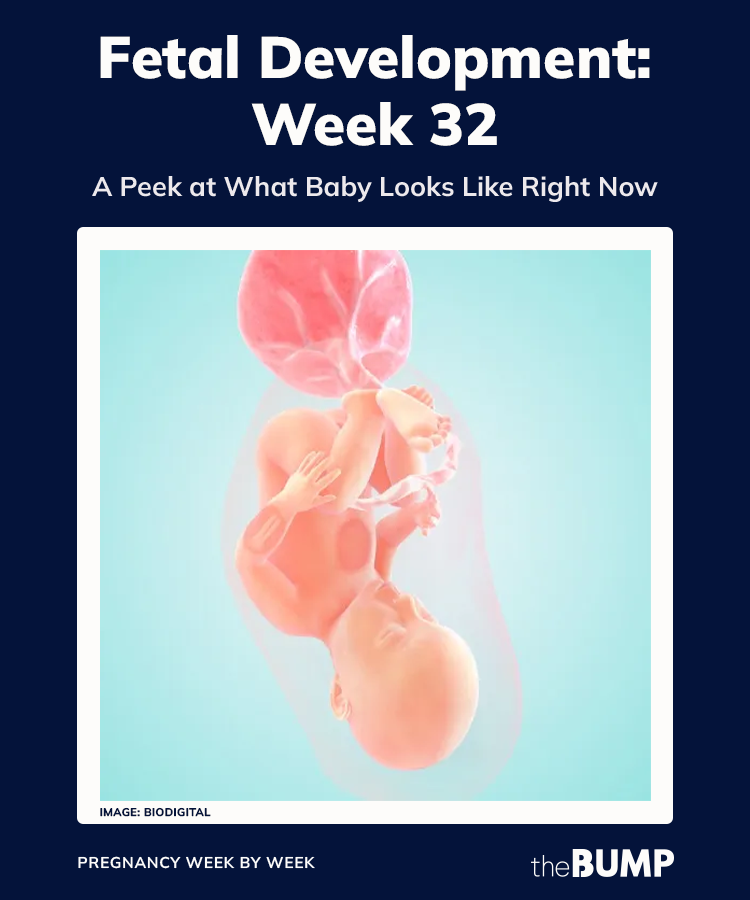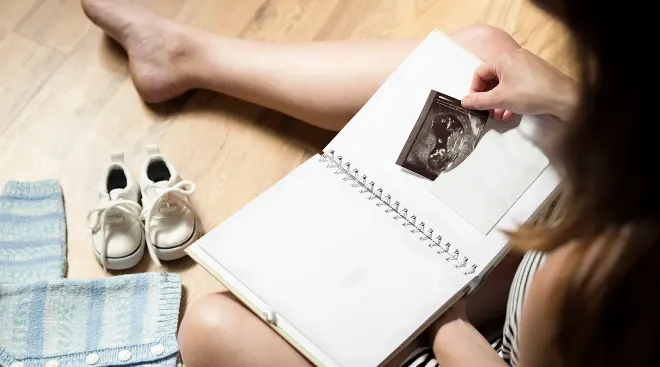- Soon, baby will “drop” from up near your ribs to down near your pelvis.
- Baby is most likely positioned head down at this point. Don’t panic if your ob-gyn or midwife says that they’re in breech position. There’s still time for your little one to turn.
- If you’re expecting multiples or have a high-risk pregnancy, your doctor may have ordered a 3D/4D ultrasound. (Yes, you’ll be able to discern baby’s facial features.)
- You might be feeling a little sticky down there. Vaginal discharge picks up in preparation for labor and delivery. (This is a good thing that helps prevent infections!)
- Watch for those Braxton Hicks practice contractions. They can be a bit uncomfortable, but should go away with movement. If they get more intense and more frequent, give a call to your doctor or midwife to make sure it’s not preterm labor.
Ready or not?! At 32 weeks pregnant, baby’s birth still seems far into the future, but you and baby are getting ready in a lot of ways… just in case there’s an early arrival. You’re probably dealing with some end-of-pregnancy to-dos, like telling your health insurance there’ll be a new arrival soon, and figuring out how the heck to install an infant car seat.
Baby is getting ready for their descent and, as we mentioned, is likely in the head-down position now. They’re probably feeling even more cramped.
Sudden loud noises may make baby startle by week 32. Fetal hearing is fully formed by about week 29 of pregnancy, which means baby can hear and begin to process a lot of what’s going on outside of the womb. That doesn’t mean baby’s hearing is fully matured: In fact, the period from 25 weeks of pregnancy until baby is about 5 to 6 months old is critical for the development of the ear-brain connection. Stimulation—especially meaningful sounds like speech and music—is critical to help baby learn to discern and understand the world around them.
There’s a reason Grandma will want to pinch baby’s cherubic cheeks. From here on out, baby’s objective is to put on weight—which will make symptoms for you, like breathlessness, even more pronounced. Baby is accumulating fat at a breakneck pace, which they’ll use to keep warm outside of your temperature-controlled womb. At birth, about 14 percent of baby’s body weight will be fat; body fat stores will increase to around 30 percent by the time baby is 6 months old!
How big is baby at 32 weeks?
Your 32-week baby is as big as a squash. Still growing strong, baby measures about 16.7 inches and weighs between 4 and 4.5 pounds at 32 weeks pregnant.
Are babies fully developed at 32 weeks?
They’re getting closer every week as you near the end of pregnancy. Most development is done by now—baby has even started to "practice" breathing!—and the major work left is gaining weight. If baby’s born at 32 weeks, they would still be only around 4-4.5 pounds, which is considered low birth weight.
32 weeks pregnant is how many months?
Thirty-two weeks pregnant in months is around eight months pregnant. (Remember, though, most doctors track your progress in weeks, not months.)
32 week ultrasound
You’ll probably have a 32-week pregnancy checkup, since most OBs like to see their patients about every other week at this point in pregnancy. You probably won’t have a 32 weeks pregnant ultrasound, though—unless you have pregnancy complications or there’s something specific your doctor wants to check. For example, for women who are 32 weeks pregnant with twins, the doctor might want to perform extra monitoring from week 30 on.
Either way, you’re just weeks away from meeting your baby (or babies)! Isn’t it exciting?
Intensity is building in the symptoms department, since heartburn and contractions tend to get more noticeable in the third trimester. But we’re guessing you’re so excited about baby’s impending arrival, these 32 weeks pregnant symptoms aren’t slowing you down—at least not too much.
More Braxton Hicks contractions
Those “practice contractions” are likely getting more frequent and stronger. (This might be confused with 32 weeks pregnant cramping.) There’s one big difference between Braxton Hicks contractions and the real deal: These guys are painless (they just feel like the uterus is tightening) and go away. Real contractions just keep coming. Women who are 32 weeks pregnant with twins are at higher risk for preterm labor, so definitely watch for contractions that don’t let up.
Darker nipples
Whoa! Those areolas might look darker thanks to hormonal changes. No one knows exactly why, but one theory is they darken so baby can see them better for breastfeeding. Your body is pretty amazing, huh?
Shortness of breath
Don't worry: Baby is getting plenty of air. You’re not, though, so don’t push yourself too hard if you have trouble catching your breath.
Heartburn
Check with your doctor first, but she’ll likely tell you to go ahead and pop an antacid. They’re safe for most moms-to-be to take during pregnancy if you struggle with heartburn.
Leaky boobs
Your breasts are probably noticeably bigger and they may even have begun producing colostrum, which is the thick yellow fluid that baby will eat in the first few days of life. Don’t be surprised to see a little bit leaking at this point.
Vaginal discharge
The increased discharge is your body’s way of preparing for delivery; it prevents infection down there. Keep your eye out for the mucus plug—this thick, gooey (sometimes bloody) substance covers the cervix until a few days (or just hours) before labor, when your body expels it. Another thing to keep an eye on: discharge that seems more like a watery liquid. If you’re having a constant flow that’s more like water than discharge, your water might have broken, causing a slow leak. If that’s the case, call the OB and get to the hospital, stat.
A 32 weeks pregnant belly should measure about 30 to 34 centimeters from the top of the uterus to the pelvic bone. If you’re 32 weeks pregnant with twins, you’re obviously feeling more weighed down than other 32 weeks pregnant women. And chances are, you’re also even closer to delivery, since the average twin pregnancy is considered full term at 37 weeks, with the typical twin pregnancy lasting 35 to 36 weeks.
How can you tell if baby is head down at 32 weeks?
Sometime between now and around week 34, baby will “drop” from up near your ribs to down near your pelvis, where they’ll hang out in the head-down position until delivery. When this happens, you may notice you suddenly go from “carrying high” to “carrying low.” This isn’t a guarantee, though; some babies don’t drop until Mom is actually in labor.
Is 32 weeks safe to deliver?
It’s still a little too early to deliver baby at 32 weeks. If babies are born any time before 37 weeks, they are considered premature. There are many different medical treatments available for babies born early, which may include a stay in a neonatal intensive care unit (NICU) until baby is ready to go home. Don’t panic—you’ve probably developed a good relationship with your OB at this point, and you can trust you and baby will be in good hands.
Have your support person attend those OB appointments, especially the last few weeks of your pregnancy to help prepare them for labor and delivery. Remind them to be as proactive as possible, when helping, instead of taking a back seat.
You’ve got this—only about eight weeks left to go! No time like the present; here’s what you can do this week to prioritize your health and that of baby’s.
Smaller is better when it comes to meals
Avoid dreaded heartburn by not filling your plate or going for seconds. Small meals are more manageable for your digestive system if you’ve been dealing with heartburn or acid reflux. Just eat more frequently, about five or six times a day, and continue to avoid foods that are heavy on fat or spiciness.
Maintain good posture
Hunching over can make it harder to breathe—and who needs that when you’re 32 weeks pregnant? Let your lungs fill with much-needed air by sitting or standing up straight; this can also help relieve any third-trimester aches and pains too.
Keep your underwear clean and dry
Yes, this is a good hygiene tip at any time, but especially during pregnancy if you have vaginal discharge. Using a pantiliner or wearing cotton underwear and changing it when needed not only keeps you comfortable, but it may also make it easier to monitor discharge for any signs of color or texture changes that could need medical attention.
Take a short walk
If you’ve been lying down and your Braxton Hicks contractions aren’t letting up, a little exercise may do the trick. Try walking for a bit, but don’t go too far—if the contractions don’t stop, they may be the real thing, and you’ll need to call your doctor.
Frequently Asked Questions
When do cervix checks start?
Most moms don’t need cervical checks until they have signs of labor. In a cervical exam, your practitioner will insert a gloved hand into the vagina to check whether your cervix has dilated (opened) or effaced (thinned), which are signs that your body is preparing for labor.
Some practitioners do perform regular cervical exams in the final weeks of pregnancy, but you typically can ask them to forgo these checks. Your practitioner may recommend cervical exams for other reasons, including if you’re at risk for preterm birth or you need to be induced for medical reasons (for example, if you have severe preeclampsia).
Why do I experience nausea after eating during pregnancy?
Nausea at this late stage of pregnancy is often due to gastrointestinal reflex disease (GERD). While you might associate GERD with heartburn—that unpleasant burning sensation in your chest—it can also cause nausea and vomiting. GERD is extremely common in the third trimester, due to hormones and the pressure of your growing bump on your stomach.
To relieve GERD, try to eat smaller meals more often (instead of three big meals per day) and cut back on rich and fatty foods. Talk to your practitioner if symptoms continue to bother you, or if you’re concerned for any other reason. Your doctor may recommend pregnancy-safe medications, such as antacids or alginates.
Why am I feeling pressure in my pelvis and how can I relieve it?
Later in pregnancy, your baby begins to engage in your pelvis—or move from higher up in your abdomen down toward your cervix, in preparation for birth. This may cause you to feel some pressure in your pelvis. Pelvic pressure and pain can also be a symptom of pelvic girdle pain, which happens when hormones loosen up your ligaments and your growing baby puts pressure on your joints.
To relieve the pressure, stay active, get up and move around every 30 minutes when you’re sitting, stand on two legs (not one), and keep your legs together when you turn over in bed. Be sure to talk to your practitioner if it’s really bothering you: They may recommend working with a physical therapist, who can teach you exercises to address the discomfort.
Is it too late to get a prenatal massage? What pressure points should be avoided?
Prenatal massage is safe in most cases throughout pregnancy—and it can help improve sleep, reduce stress and relieve common aches and pains. That said, be sure to see a massage therapist who is trained in prenatal massage, and check with your doctor first if you have any pregnancy complications or health conditions.
Some techniques can be dangerous if you have blood clots and potentially cause uterine contractions and even induce premature labor. Massage therapists should avoid putting too much pressure on the abdomen and back, as well as around your ankles and your big, second and baby toes.
What are signs my amniotic fluid level is healthy (or not)?
Oligohydramnios (low levels of amniotic fluid) and polyhydramnios (too much amniotic fluid) are relatively rare, affecting between 1 to 4 percent of all pregnant people before their due dates. They can be signs of a more serious condition, such as diabetes or preeclampsia.
You can rely on your practitioner to keep an eye on amniotic fluid levels (that’s one thing they’re checking when they measure your bump). They may suspect abnormal amniotic fluid levels if your uterus measures too big or too small for how far along you are in your pregnancy. Other signs include shortness of breath, swelling in the feet and ankles, pain around your bump, fluid leaking from your vagina, and not gaining enough pregnancy weight.
Phew, sleeping was rough. I'm a back sleeper, and rolling from one side to the other was brutal. The one thing that did help was a massive pregnancy pillow. It was shaped like a U so it could be scrunched, tucked, and manipulated in almost every way for maximum comfort.
Please note: The Bump and the materials and information it contains are not intended to, and do not constitute, medical or other health advice or diagnosis and should not be used as such. You should always consult with a qualified physician or health professional about your specific circumstances.
Kaiser Permanente, Pregnancy: Dropping (Lightening), July 2023
Cigna, Ultrasound in Pregnancy (including 3D, 4D and 5D Ultrasound), June 2023
Mayo Clinic, Labor and Delivery, Postpartum Care
Cleveland Clinic, Signs That Labor Is 24 to 48 Hours Away, April 2021
StatPearls, Braxton Hicks Contractions, August 2023
American Pregnancy Association, 32 Weeks Pregnant
American Journal of Obstetrics & Gynecology, Fetal Age and Patterns of Human Fetal Breathing Movements, July 1980
Stanford Medicine Children's Health, Prematurity
Mayo Clinic, Prenatal Care: 3rd Trimester Visits, July 2022
StatPearls, Sonography 3rd Trimester and Placenta Assessment, Protocols, and Interpretation, June 2023
Ultrasound, Ultrasound Surveillance in Twin Pregnancy: An Update for Practitioners, August 2022
Mayo Clinic, 3rd Trimester Pregnancy: What to Expect, March 2022
Advances in Experimental Medicine and Biology, Anatomy and Physiology of the Breast during Pregnancy and Lactation, August 2020
Harvard Medical School, Shortness of Breath In Pregnancy
University of Chicago Medicine, GERD and Pregnancy
StatPearls, Anatomy, Colostrum, February 2023
Cleveland Clinic, Water Breaking, October 2022
Cleveland Clinic, Fundal Height, January 2022
Cleveland Clinic, Twin Pregnancy, June 2022
Cleveland Clinic, Fetal Positions for Birth, March 2020
American College of Obstetricians and Gynecologists, How to Tell When Labor Begins, November 2021
March of Dimes, Premature Babies, October 2019
Cleveland Clinic, Fetal Positions for Birth, March 2020
Cleveland Clinic, Heartburn During Pregnancy, January 2021
Tufts Medical Center, Trouble Breathing During Pregnancy
Women’s Health, Role of Female Intimate Hygiene in Vulvovaginal Health: Global Hygiene Practices and Product Usage, September 2017
Learn how we ensure the accuracy of our content through our editorial and medical review process.
Navigate forward to interact with the calendar and select a date. Press the question mark key to get the keyboard shortcuts for changing dates.
















































